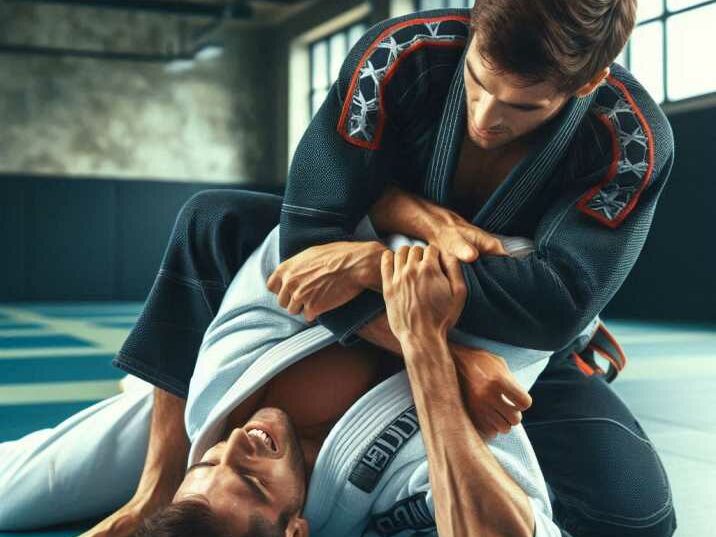Comparing Brazilian Jiu-Jitsu (BJJ) and Mixed Martial Arts (MMA)
Introduction
Table of Contents
When you hear about combat sports, two names often pop up—Brazilian Jiu-Jitsu (BJJ) and Mixed Martial Arts (MMA). While both sports involve grappling and fighting techniques, they are distinct in many ways. This article aims to explore the key differences between Brazilian Jiu-Jitsu vs MMA, making it easy for even a fifth-grader to understand.

What is Brazilian Jiu-Jitsu (BJJ)?
Brazilian Jiu-Jitsu is a grappling martial art that focuses on submission holds and ground fighting. Developed from Judo, BJJ emphasizes techniques that allow a smaller person to defend against a larger opponent by using leverage and joint locks.
Key Features of BJJ Explained
Ground Fighting:
Most techniques in BJJ are executed on the ground.
- Detail: Brazilian Jiu-Jitsu primarily focuses on ground fighting, which is distinct from many other martial arts that emphasize standing combat. Practitioners learn to control and dominate opponents through various positions and transitions on the ground. Techniques such as guard, mount, and side control are essential aspects of ground fighting in BJJ. The aim is to use leverage and body mechanics to control an opponent, regardless of size and strength differences.
Submission Holds:
Chokes and joint locks are essential techniques.
- Detail: Submissions are the cornerstone of BJJ, and they involve forcing an opponent to “tap out” (submit) due to a choke or joint lock. Chokes, such as the rear-naked choke and the guillotine choke, restrict blood flow or air to compel the opponent to surrender. Joint locks, like the armbar or the kimura, apply pressure on joints (elbows, shoulders, knees) to cause pain or potential injury, making the opponent submit. These techniques emphasize precision and technique over brute strength.
Gi and No-Gi:
Practitioners can train with a traditional Gi (uniform) or without (No-Gi).
- Detail: BJJ can be practiced in two primary formats: Gi and No-Gi. In Gi BJJ, practitioners wear a traditional uniform (Gi), which includes a jacket, pants, and belt. The Gi allows for grips and holds on the fabric, adding another layer of techniques. No-Gi BJJ, on the other hand, involves training in athletic wear like rash guards and shorts, without the use of the Gi. This format emphasizes speed and athleticism, as it relies more on body grips and less on fabric holds.
Self-Defense:
BJJ teaches techniques effective for self-defense situations.
- Detail: One of the fundamental aspects of BJJ is its practical application in self-defense. BJJ teaches individuals how to protect themselves against larger and stronger attackers by using leverage and technique. The focus on ground control and submissions makes it particularly effective in real-life scenarios where fights often end up on the ground. BJJ also includes techniques to escape from common holds and attacks, making it a valuable self-defense skill for people of all sizes and ages.
What is Mixed Martial Arts (MMA)?
Mixed Martial Arts is a full-contact combat sport that incorporates techniques from various martial arts, including boxing, wrestling, Muay Thai, and BJJ. Fighters in MMA use strikes, takedowns, and submissions to win matches.
Key Features of MMA Explained
Striking and Grappling:
Combines both striking (punches, kicks) and grappling (takedowns, submissions).
- Detail: Mixed Martial Arts (MMA) is unique in that it integrates techniques from various combat sports, allowing fighters to use both striking and grappling. Striking involves punches, kicks, knees, and elbows derived from boxing, Muay Thai, and kickboxing. Grappling encompasses takedowns, submissions, and ground control techniques from Brazilian Jiu-Jitsu (BJJ), wrestling, and Judo. This combination makes MMA a comprehensive fighting style where competitors must be adept in both standing and ground combat to succeed.
Cage Fighting:
Most MMA fights occur in a cage, known as the Octagon.
- Detail: MMA fights typically take place in an enclosed area called the Octagon, an eight-sided cage designed to keep fighters safe and the action contained. The cage prevents fighters from falling out of the ring and allows for continuous action without interruptions. The design of the Octagon also adds a strategic element, as fighters can use the cage to their advantage for positioning, takedowns, and controlling their opponents. It ensures a fair and controlled environment for both striking and grappling exchanges.
Versatility:
Fighters need to be well-rounded in multiple martial arts.
- Detail: To be successful in MMA, fighters must develop a well-rounded skill set, incorporating techniques from various martial arts disciplines. This versatility means training in striking arts like boxing and Muay Thai for effective stand-up fighting, while also learning grappling arts like wrestling and BJJ for takedowns, submissions, and ground control. The most successful MMA fighters are those who can seamlessly transition between striking and grappling, adapting their strategies based on their opponents’ strengths and weaknesses.
Professional Sport:
MMA has major organizations like the UFC that host professional fights.
- Detail: MMA has grown into a globally recognized professional sport, with major organizations like the Ultimate Fighting Championship (UFC), Bellator MMA, and ONE Championship hosting events. These organizations provide structured competition, professional rankings, and opportunities for fighters to compete at the highest levels. The UFC, in particular, has been instrumental in popularizing MMA worldwide, offering fighters lucrative contracts, media exposure, and the chance to become world champions. Professional MMA events are broadcast internationally, attracting millions of viewers and fostering a competitive and dynamic sports environment.
Key Differences Between BJJ and MMA
Objectives
- BJJ: The primary goal of Brazilian Jiu-Jitsu (BJJ) is to control and submit the opponent through grappling techniques. Practitioners aim to dominate their opponents using positions like guard, mount, and side control, and to achieve submissions such as chokes and joint locks. The focus is on leveraging technique and strategy to overcome size and strength disparities.
- MMA: Mixed Martial Arts (MMA) aims to defeat the opponent using a combination of grappling, striking, and submissions. Fighters can win by knockout, submission, or judges’ decision. The objective is to be proficient in multiple combat disciplines, allowing for a versatile and adaptable fighting style.
Techniques
- BJJ: BJJ focuses exclusively on ground techniques. Common techniques include arm bars, triangle chokes, sweeps, and guard passes. The emphasis is on controlling the opponent and applying submissions to force them to tap out. Techniques are designed to use leverage and precision rather than brute strength.
- MMA: MMA incorporates a broad range of techniques from various martial arts. This includes striking techniques like punches, kicks, elbows, and knees, as well as grappling techniques like clinch work, takedowns, and submissions. Ground-and-pound, where a fighter strikes an opponent on the ground, is also a key component of MMA.
Training
- BJJ: Training in BJJ involves extensive drilling of techniques, sparring sessions (known as rolling), and practicing specific moves and sequences. Classes often start with a warm-up, followed by technique instruction, drilling, and live rolling to apply techniques in a controlled sparring environment.
- MMA: MMA training is comprehensive, covering multiple aspects of combat. It includes striking drills, grappling practice, conditioning workouts, and sparring sessions that combine striking and grappling. Fighters train to be well-rounded, often cross-training in disciplines like boxing, Muay Thai, wrestling, and BJJ to develop a versatile skill set.
Attire
- BJJ: Practitioners of BJJ wear a Gi or No-Gi attire. The Gi is a traditional uniform consisting of a jacket, pants, and belt, which allows for grips and holds. No-Gi attire typically includes a rash guard and shorts, focusing on body grips and speed.
- MMA: MMA fighters wear shorts and gloves, without a traditional uniform. The gloves are small, open-fingered gloves designed to protect the hands while allowing for grappling. Fighters also wear mouthguards and, in some cases, shin guards during training.
Competitions
- BJJ: BJJ competitions are grappling-only events. Matches are won by points, submission, or referee decision. Points are awarded for achieving dominant positions and performing specific techniques. Competitions are often divided by weight class, belt level, and age group.
- MMA: MMA competitions are full-contact fights with rounds, judges, and specific rules. Fighters can win by knockout, submission, or judges’ decision based on scoring criteria like effective striking, grappling, and control. Major MMA organizations, like the UFC, host these events in a cage (Octagon) with strict regulations to ensure safety and fairness.

Choosing Between BJJ and MMA
Deciding whether to pursue Brazilian Jiu-Jitsu (BJJ) or Mixed Martial Arts (MMA) can depend on various factors. Your personal goals, interests, and physical abilities all play crucial roles in making this decision. If your primary interest is in grappling and learning a martial art that can be highly effective in self-defense scenarios, BJJ might be the right choice for you. On the other hand, if you are interested in a more well-rounded combat sport that includes striking and grappling, and you enjoy the idea of competing in a professional setting, MMA could be more suitable.
Benefits of Practicing BJJ
Physical Fitness
BJJ improves overall fitness, strength, and endurance.
Mental Toughness
It builds mental resilience and the ability to stay calm under pressure.
Self-Defense
Provides effective techniques for real-life self-defense situations.
Community
Joining a BJJ gym offers a sense of community and belonging.
Benefits of Practicing MMA
Comprehensive Skill Set
MMA provides a well-rounded skill set in striking and grappling.
High-Intensity Training
Excellent for improving cardiovascular health and physical conditioning.
Professional Opportunities
Offers paths to professional fighting and competition.
Mental Discipline
Teaches discipline, focus, and the ability to perform under pressure.
Common Myths About Differences Between Brazilian Jiu-Jitsu vs MMA
Myth 1: You Need to Be in Peak Physical Condition to Start
Many people believe that you must be in top physical shape to begin training in BJJ or MMA. While being fit can be advantageous, it’s not a requirement. Training in either discipline can greatly improve your fitness over time. Both sports are inclusive and offer beginner classes tailored to different fitness levels.
Myth 2: BJJ and MMA Are Only for Young People
Another common myth is that these combat sports are only suitable for younger individuals. In reality, people of all ages can practice BJJ and MMA. Many gyms offer classes for adults, teens, and even children, making it a family-friendly activity.
Myth 3: BJJ and MMA Are Too Dangerous
It’s a misconception that practicing BJJ or MMA is extremely dangerous. While there is an inherent risk of injury with any physical activity, proper training, experienced instructors, and adherence to safety protocols can minimize these risks. Most gyms prioritize safety and ensure that techniques are taught and practiced responsibly.
Myth 4: BJJ is All About Strength
Some people think that BJJ relies heavily on physical strength. However, BJJ is designed to use leverage, technique, and strategy, allowing smaller practitioners to overcome larger and stronger opponents. Strength can be an asset, but it’s not the defining element of success in BJJ.
Myth 5: MMA is All About Brutality
MMA is often perceived as a brutal sport with a focus on inflicting damage. This portrayal overlooks the skill, strategy, and respect involved in MMA. Fighters train rigorously and follow strict rules and guidelines to ensure a competitive but safe environment.
Table of Information about Brazilian Jiu-Jitsu and Mixed Martial Arts
| Feature | Brazilian Jiu-Jitsu (BJJ) | Mixed Martial Arts (MMA) |
|---|---|---|
| Objective | Control and submit the opponent | Defeat the opponent using strikes and grappling |
| Techniques | Ground techniques, submissions | Strikes, takedowns, submissions |
| Training | Drills, sparring, technique practice | Striking drills, grappling, conditioning, sparring |
| Attire | Gi or No-Gi | Shorts and gloves |
| Competitions | Grappling-only events | Full-contact fights with rounds and judges |
Conclusion
Differences Between Brazilian Jiu-Jitsu vs MMA, both BJJ and MMA offer unique benefits and challenges. Brazilian Jiu-Jitsu provides a thorough understanding of ground techniques and submissions, making it an excellent choice for self-defense and grappling enthusiasts. Mixed Martial Arts offers a diverse range of techniques from multiple disciplines, suited for those who enjoy a mix of striking and grappling. Ultimately, the choice between BJJ and MMA depends on your personal preferences and what you hope to achieve through training. Whether you choose BJJ or MMA, both paths offer opportunities for immense personal growth, physical fitness, and the development of valuable self-defense skills.
FAQs
1. Is BJJ good for self-defense?
Yes, BJJ is excellent for self-defense as it focuses on controlling and submitting an opponent.
2. Can I train both BJJ and MMA?
Absolutely, many fighters train in both to become well-rounded martial artists.
3. Do I need to be fit to start BJJ or MMA?
No, you can start at any fitness level. Training will help you get in shape.
4. Which is more physically demanding, BJJ or MMA?
MMA is generally more physically demanding due to its combination of striking and grappling.
5. Are there age restrictions for starting BJJ or MMA?
Most gyms offer classes for various age groups, so you can start at almost any age.


